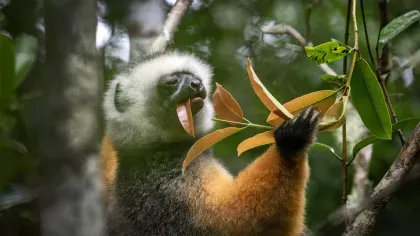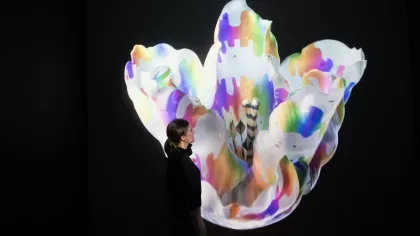Flowers rare and wonderful
Julia Buckley from the Illustrations team looks at the work of Australian artist Ellis Rowan and the incredible life she led in her quest to document plants.

My attention was recently drawn to a collection of pictures of New Guinea plants by the Australian artist Ellis Rowan held in Kew’s Library, Art & Archives. The Collection comprises 108 paintings and I was curious to know why all of the images adhered to the same circular format.
Ellis Rowan was born in Melbourne in 1848 and, like her contemporary the British artist Marianne North, her lifelong obsession with documenting plants led her to venture into inhospitable lands where she found herself facing various dangers; dangling from precipices and nearly drowning.
Ellis Rowan & Marianne North
Rowan met Marianne North in 1880 and she proved to be a profound influence on the Australian artist, cementing her ambition to pursue the painting of plants Rowan declared; ‘..after my conversation with her, I resolved to do as she had done. I would travel the world in search of flowers rare and wonderful’.
In turn, Marianne North described Rowan in her autobiography as '... a very pretty fairy-like little woman, always over-dressed, and afraid to go out of the house because people stared at her. I admired her for her genius and prettiness; she was like a charming spoiled child'.
Ellis Rowan’s talent was recognised from an early age and supported by Baron Ferdinand von Mueller, government botanist of Victoria, who assisted her by classifying many of the plants she illustrated. She went on to forge a successful career, winning numerous awards, though she suffered criticism from her fellow artists who disapproved of the accolades she received under the sphere of high art seeing her choice of subject matter as less prestigious than their own.North is likely to have encouraged Rowan in the technique of oil painting though her preferred medium seems to have been watercolour and gouache on toned paper in the style of the pictures at Kew. As with North, she valued painting from life and her work suggests the habitat in which it was located. She adopted a distinctive slanted signature, working it into the angles of twigs and leaves on her paintings – here it appears alongside an illustration of an Ipomoea.
Circular for a reason
Kew Bulletin of 1930 describes the acquisition of the Ellis Rowan paintings in December 1929 from Mr. W.H. Flavelle formerly of Sydney. Further investigation reveals that the Flavelle Brothers were a firm dealing in jewellery and fine china who commissioned Rowan to travel to New Guinea to illustrate birds and plants for use on ceramics produced by the Royal Worcester Porcelain Company. This explains the uniform template applied to each picture! Rowan made two seven month long trips to New Guinea from 1916 starting out at the age of 68. Even the seemingly fearless Rowan admitted that her visits to the wilds of this country called for ‘a mustering of some courage’.
Kew Bulletin describes ‘each floral study....in a circle about nine inches in diameter. Analyses of the flowers are not given, identification has not been attempted by the artist’. It seems that identifications have been made since their receipt as the majority of plants are named to genus level though a number are still listed as unknown.
A celebrated artist
Today Ellis Rowan is celebrated as one of the great Australian artists of the last century. Though her illustrations may not strictly adhere to the criteria necessary for a scientific botanical illustration the works at Kew are accurate and important records of New Guinea plants as well as evidence of the skill of a truly remarkable artist of indomitable spirit.
- Julia -


